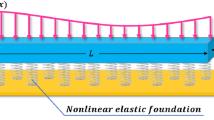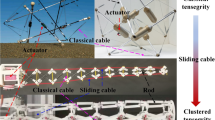Abstract
A topology optimization methodology is proposed for the flexible multibody system undergoing both large overall motion and large deformation. The system of concern is modeled via the absolute nodal coordinate formulation. The equivalent static load method is employed to transform the topology optimization of the nonlinear dynamic response of the system into a static one, and evaluated to adapt to the absolute nodal coordinate formulation by splitting the elastic deformations of the flexible components from the overall motions of those components. During the static topology optimization, the material interface is implicitly described as the zero level set of a higher-dimensional scalar function. Then, the semi-implicit level set method with the additive operator splitting algorithm is employed to solve the corresponding Hamilton-Jacobi partial differential equation. In addition, the expert evaluation method of weights based on the grey theory is utilized to define the objective function, and a modified augmented Lagrange multiplier method is proposed to treat the inequality volume constraint so as to avoid the oscillation and drift of the volume. Finally, two numerical examples are provided to validate the proposed methodology.






















Similar content being viewed by others
References
Allaire G, Jouve F, Toader A (2004) Structural optimization using sensitivity analysis and a level-set method. J Comput Phys 194(1):363–393
Arnold M, Brüls O (2007) Convergence of the generalized-α scheme for constrained mechanical systems. Multibody Sys Dyn 18:185–202
Birgin EG, Castillo RA, Inez JMM (2005) Numerical comparison of augmented lagrangian algorithms for nonconvex problems. Comput Optim Appl 31:31–55
Brüls O, Lemaire E, Duysinx P, Eberhard P (2011) Optimization of multibody systems and their structural components. Multibody Dynamics Comput Methods App 23:49–68
Chen SK, Chen W (2011) A new level-set based approach to shape and topology optimization under geometric uncertainty. Struct Multidiscip Optim 44(1):1–18
Chen SK, Chen W, Lee SH (2010) Level set based robust shape and topology optimization under random field uncertainties. Struct Multidiscip Optim 41(4):507–524
Deaton JD, Grandhi RV (2014) A survey of structural and multidisciplinary continuum topology optimization: post 2000. Struct Multidiscip Optim 49(1):1–38
Deng JL (1989) The introduction to grey system theory. J Grey System 1:1–24
Dufva K, Shabana AA (2005) Analysis of thin plate structures using the absolute nodal coordinate formulation proceedings of the institution of mechanical engineers. Part K J Multi-Body Dyn 219(4):345–355
Eberhard P, Schiehlen W (2006) Computational dynamics of multibody systems: history, formalisms, and applications. J Comput Nonlinear Dyn 1(1):3–12
Gerstmayr J, Sugiyama H, Mikkola A (2013) Review on the absolute nodal coordinate formulation for large deformation analysis of multibody systems. J Comput Nonlinear Dyn 8(3):031016
Guo X, Cheng GD (2010) Recent development in structural design and optimization. Acta Mech Sinica 26(6):807–823
Guo X, Zhang WS, Zhong WL (2014) Doing topology optimization explicitly and geometrically-a new moving morphable components based framework. J Appl Mech 81(8):081009
Häussler P, Emmrich D, Müller O, Ilzhöfer B, Nowicki L, Albers A (2001) Automated topology optimization of flexible components in hybrid finite element multibody systems using ADAMS/Flex and MSC.construct. In: 16th European ADAMS Users’ Conference, Berchtesgaden, Germany, 14–15 November
Häussler P, Minx J, Emmrich D (2004) Topology optimization of dynamically loaded parts in mechanical systems: Coupling of MBS, FEM and structural optimization. In: NAFEMS seminar analysis of multi-body systems using FEM and MBS, Wiesbaden, Germany
Held A, Seifried R (2012) Topology optimization of members of elastic multibody systems. Proc Appl Math Mech 12(1):67–68
Held A, Knüfer S, Seifried R (2015) Topology optimization of members of dynamically loaded flexible multibody systems using integral type objective functions and exact gradients. In: 11th World Congress on Structural and Multidisciplinary Optimization, Sydney Australia, 7–12 June
Held A, Nowakowski C, Moghadasi A, Seifried R, Eberhard P (2016) On the influence of model reduction techniques in topology optimization of flexible multibody systems using the floating frame of reference approach. Struct Multidiscip Optim 53(1):67–80
Hong EP, You BJ, Kim CH, Park GJ (2010) Optimization of flexible components of multibody systems via equivalent static loads. Struct Multidiscip Optim 40(1–6):549–562
Jorge N, Wright SJ (2006) Numerical optimization. Springer, New York
Kang BS, Choi WS, Park GJ (2001) Structural optimization under equivalent static loads transformed from dynamic loads based on displacement. Comput Struct 79(2):145–154
Kang BS, Park GJ, Arora JS (2005) Optimization of flexible multibody dynamic systems using the equivalent static load method. AIAA J 43(4):846–852
Lee HA, Park GJ (2015) Nonlinear dynamic response topology optimization using the equivalent static loads method. Comput Methods Appl Mech Eng 283:956–970
Liu C, Tian Q, Yan D, Hu HY (2013) Dynamic analysis of membrane systems undergoing overall motions, large deformations and wrinkles via thin shell elements of ANCF. Comput Methods Appl Mech Eng 258:81–95
Luo Z, Yang JZ, Chen LP, Zhang YQ, Abdel-Malek K (2006) A new hybrid fuzzy-goal programming scheme for multi-objective topological optimization of static and dynamic structures under multiple loading conditions. Struct Multidiscip Optim 31(1):26–39
Luo JZ, Luo Z, Chen LP, Tong LY, Wang MY (2008) A semi-implicit level set method for structural shape and topology optimization. J Comput Phys 227(11):5561–5581
Moghadasi A, Held A, Seifried R (2014) Topology optimization of flexible multibody systems using equivalent static loads and displacement fields. Proc Appl Math Mech 14(1):35–36
Oral S, Ider SK (1997) Optimum design of high-speed flexible robotic arms with dynamic behavior constraints. Comput Struct 65:255–259
Sethian JA (1999) Level set methods and fast marching methods: evolving interfaces in computational geometry, fluid mechanics, computer version and material science. Cambridge University Press, UK
Sethian JA, Wiegmann A (2000) Structural boundary design via level set and immersed interface methods. J Comput Phys 163(2):489–528
Shabana AA (1996) An absolute nodal coordinates formulation for the large rotation and deformation analysis of flexible bodies. Report, No. MBS96-1-UIC, University of Illinois at Chicago
Shabana AA (1997) Flexible multibody dynamics: review of past and recent developments. Multibody Sys Dyn 1(2):189–222
Shabana AA (2005) Dynamics of multibody systems. Cambridge University Press, New York
Sigmund O, Maute K (2013) Topology optimization approaches: a comparative review. Struct Multidiscip Optim 48(6):1031–1055
Sun JL, Tian Q, Hu HY (2016) Structural optimization of flexible components in a flexible multibody system modeled via ANCF. Mech Mach Theory 104:59–80
Tian Q, Zhang YQ, Chen LP, Yang JZ (2009) Two-link flexible manipulator modeling and tip trajectory tracking based on the absolute nodal coordinate method. Int J Robot Autom 24(2):103–114
Tian Q, Zhang YQ, Chen LP, Yang JZ (2010) Simulation of planar flexible multibody systems with clearance and lubricated revolute joints. Nonlinear Dyn 60(4):489–511
Toheed G, Claus F, Elmqvist H (2015) Structural topology optimization of multibody systems. In: ECCOMAS Thematic Conference on Multibody Dynamics, Barcelona, Catalonia, Spain, 29 June-2 July
Tromme E, Tortorelli D, Brüls O, Duysinx P (2015a) Structural optimization of multibody system components described using level set techniques. Struct Multidiscip Optim 52(5):959–971
Tromme E, Brüls O, Duysinx P (2015b) Weakly and fully coupled methods for structural optimization of flexible mechanisms. Multibody Sys Dyn. doi:10.1007/s11044-015-9493-4
van Dijk NP, Maute K, Langelaar M, van Keulen F (2013) Level-set methods for structural topology optimization: a review. Struct Multidiscip Optim 48(3):437–472
Wang MY, Wang XM, Guo DM (2003) A level set method for structural topology optimization. Comput Methods Appl Mech Eng 192:227–246
Wang QT, Tian Q, Hu HY (2014) Dynamic simulation of frictional contacts of thin beams during large overall motions via absolute nodal coordinate formulation. Nonlinear Dyn 77(4):1411–1425
Wang QT, Tian Q, Hu HY (2016) Dynamic simulation of frictional multi-zone contacts of thin beams. Nonlinear Dyn 83(4):1919–1937
Wasfy TM, Noor AK (2003) Computational strategies for flexible multibody systems. Appl Mech Rev 56(6):553–613
Weickert J (2001) Efficient image segmentation using partial differential equations and morphology. Pattern Recogn 34(9):1813–1824
Weickert J, Romeny BM, Viergever MA (1998) Efficient and reliable schemes for nonlinear diffusion filtering. IEEE Trans On Image Proc 7(3):398–410
Yang ZJ, Chen X, Kelly R (2012) A topological optimization approach for structural design of a high-speed low-load mechanism using the equivalent static loads method. Int J Numer Methods Eng 89(5):584–598
Zhang WS, Zhang J, Guo X (2015) Lagrangian description based topology optimization-a revival of shape optimization. J Appl Mech 83(1):1–54
Zhang WS, Yuan J, Zhang J, Guo X (2016) A new topology optimization approach based on moving morphable components (MMC) and the ersatz material model. Struct Multidiscip Optim 53(6):1243–1260
Zhao J, Tian Q, Hu HY (2011) Modal analysis of a rotating thin plate via absolute nodal coordinate formulation. J Comput Nonlinear Dyn 6(4):041013
Acknowledgments
This work was supported in part by the National Natural Science Foundation of China under Grants 11290151 and 11472042. It was also supported by Funding of Jiangsu Innovation Program for Graduate Education under Grants KYLX15_0235 and the Fundamental Research Funds for the Central Universities.
Author information
Authors and Affiliations
Corresponding author
Rights and permissions
About this article
Cite this article
Sun, J., Tian, Q. & Hu, H. Topology optimization based on level set for a flexible multibody system modeled via ANCF. Struct Multidisc Optim 55, 1159–1177 (2017). https://doi.org/10.1007/s00158-016-1558-3
Received:
Revised:
Accepted:
Published:
Issue Date:
DOI: https://doi.org/10.1007/s00158-016-1558-3




